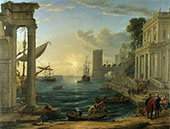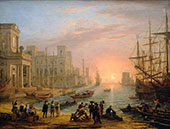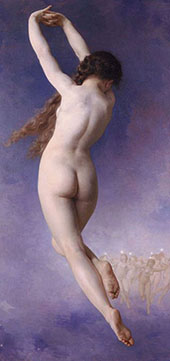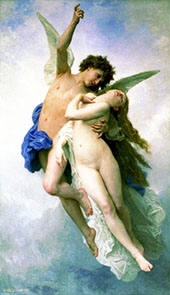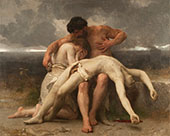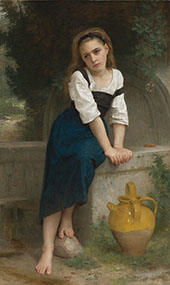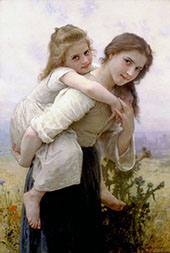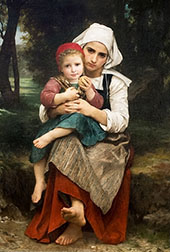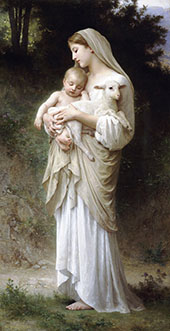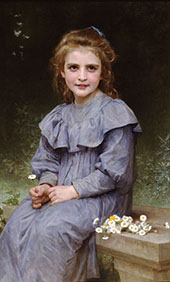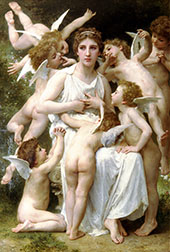Classical Art Oil Painting Reproductions
Find Classical Art oil painting replicas by Classical Art artists
Classical Art Paintings: A Brief Introduction
Classical art is something artists have taken inspiration from and rallied against since the dawn of “classical” civilizations themselves.
Nonetheless, it’s also an often misunderstood term that’s famously tricky to define. This brief introduction explains what classic oil paintings are and their defining characteristics. We’ll also examine five leading artists and their most famous classical paintings.
What does Classicism Art mean?
“classicism” refers to art taking inspiration from ancient Greece or Rome.
This period of classical antiquity, lasting from the 8th century BC to the 6th century AD, saw civilizations of the Mediterranean Sea flourish. They gained massive influence throughout Europe, Western Asia, and Northern Africa. Starting with the epic Greek poetry of Homer, the period covers the rise of Christianity, in the 1st century AD, through to the fall of the Western Roman Empire. It lasted until the decline of classical culture in the 6th century. The term includes many cultures and histories, supplying rich and varied artistic sources.
Classical art paintings' descriptions of “classic” and “classical” appeared during the 17th Century. The culture and philosophy of art from Rome and Greece were significant inspirations for writers, thinkers, artists, and architects. This style dominated Western artistic production from the late Renaissance onwards. Indeed, classical mythology and tales of ancient Greco-Roman heroes and gods became one of the most painted subjects.
What are the characteristics of Classical Art paintings?
Classical paintings are usually associated with principles of restraint and harmony. This art form emphasizes obedience to accepted composition, color, and technique forms. These standards are based on the art of ancient Greek and Rome, which classicists tried to emulate.
All artists in this genre shared a deep respect for the Greco-Roman world, often in a heavily idealized form. As the poet Edgar Allan Poe put it, artists celebrated the “glory that was Greece” and the “grandeur that was Rome.” Indeed, classicism refers to an artistic canon of widely accepted “ideal forms” and their revival in Western art. Emerging during the seventeenth century, classicism was particularly prevalent during the Age of the Enlightenment.
These developments started in the 18th century and continued into the early 19th century. The movement eventually led to more modern approaches, such as Impressionism and Expressionism.
What are the five characteristics of Classic Art?
In its simplest form, classicism refers to a philosophical and aesthetic outlook inspired by ancient Greece and Rome. While this applies to a wide variety of paintings, architecture, and literature, it resulted in five essential characteristics:
- Restrained simplicity in color and form
- Muted or calm emotions and “ideal” bodies
- Strict proportions and perspectives
- An intellectual approach to art and architecture
- Clear compositions and narratives
Speaking of the Discobolus, an iconic Greek sculpture depicting a male athlete throwing a discus, the art historian Kenneth Clark remarked how its “restraint and compression” is fundamental to its appeal. He described how violent emotion or rhythmic motion would destroy the principles of “balance and completeness.” It was only through these qualities, Clark argued, that classical artwork kept its position of authority through the centuries.
What makes a painting a Classic?
What exactly makes a classic painting is famously tricky to define. Indeed, art historians vigorously debate the differences between movements such as classicism, neo-classicism, and academicism.
While many Renaissance old masters, such as Leonardo da Vinci and Titian, focused on Greco-Roman mythology, they are not usually described as “classical” works. Instead, Renaissance oil paintings developed in the 16th and 17th centuries when paintings became more formally classical.
This involved emphasizing structure, order, geometry, and the use of grids in painting. A new generation of rigorously disciplined painters stuck to the strict teaching of Europe’s prestigious art academies. The French King Louis XIV’s court was the center of this European classicism. Indeed, the grandeur of Versailles launched some of the finest painters of the era.
However, exploring some of the most famous classical paintings is worthwhile to understand better what makes a classic painting.
What is a Classical Painting?
Here are five leading classical painters and their famous oil paintings:
1. Nicolas Poussin 1594-1665
Nicolas Poussin created some of the most famous classical paintings of all time. He grew up in France but spent most of his working life in Rome. Most Nicolas Poussin paintings focus on religious and mythological narratives, painted for private commissions.
One of Poussin’s most celebrated works is Et in Arcadia Ego, also known as The Arcadian Shepherds. This oil painting features four individuals standing around an austere tomb in a heavily stylized pastoral scene. It serves as a “memento mori” to the viewer that death remains even in the idyllic Arcadia.
As the founding father of classicism, Poussin inspired many later painters. They include Jacques Louis David, Jean Auguste Dominique Ingres, and the post-impressionist Paul Cezanne.
2. Claude Lorrain 1600-1682
A contemporary of Nicolas Poussin, Claude Lorrain is another leading French classical and baroque painter. He also spent much of his working life in Italy, reflecting the commercial importance of Rome at the time.
Unlike Poussin’s strictly mythological works, Lorrain is notable for focusing on landscape. This was incredibly unusual at the time when the more prestigious genre of history painting usually took precedence.
Lorrain’s landscapes often contained small figures, adding extra meaning to his paintings. For instance, Sunrise and View of Delphi with a Procession transform rural views into moralizing, allegorical works.
3. Alexandre Cabanel 1823-1889
As a painter working in nineteenth-century France, Alexandre Cabanel heavily drew on the works of Claude Lorrain and Nicolas Poussin. Well-known as a portrait painter, Cabanel served as Napoleon III’s preferred artist. Dedicated to the classical art movement, Cabanel produced many L’art Pompier oil paintings. Originating in the late nineteenth century, this initially derisive term refers to large “official” academic canvases.
While Cabanel produced several large history paintings, The Birth of Venus is his most famous work today. Displayed at the Paris Salon, Napoleon III immediately bought the oil painting for his private collection.
Indeed, the painting’s sexuality and classical imagery were incredibly appealing. As one art critic said, Cabanel’s Venus hovers halfway between “an ancient deity” and a “modern dream.”
4. William-Adolphe Bouguereau 1825-1905
Like Cabanel’s Venus, William-Adolphe Bouguereau is known for his classic nude oil paintings. Bouguereau produced his own La Naissance de Venus in 1879, showing Venus rising from a seashell. She is surrounded by dolphins, fifteen putti, cherubs, nymphs, and centaurs. Bouguereau often painted mythological subjects with a focus on the nude female body. Particularly popular in France and the United States, he was a famed Salon des Independents painter of the highest quality.
Alexandre Cabanel was reviled by the impressionist artists and seen as increasingly old-fashioned. Towards the end of his life, his classical art gradually fell out of favor.
5. Pierre Auguste Cot 1837-1883
As the last painter on this list, Pierre Auguste Cot produced some stunning famous oil paintings. He excelled in realistic portraiture paintings and studied under Alexandre Cabanel and William-Adolphe Bouguereau.
Pierre Cot’s Salon debut came in 1863, and his popularity and prestige grew from that moment onwards. His famous painting The Storm depicts a romantic couple in an idealized landscape. Most usually wearing a classical dress, Cot’s carefully observed figures represent the pinnacle of youthful beauty and love. As some of our most popular replica oil paintings, his reputation remains today.
Who are the lesser-known Classical painters?
In addition to well-known French masters such as Poussin, Lorrain, and Cabanel, several other renowned Classical painters existed. This included artists such as Pierre Subleyras and Guillaume Seignac. While the movement influenced many artists around the globe, it was also particularly prevalent in the UK.
Here, painters such as William Clarke Wontner is portrait painter steeped in romanticism and classicism. John William Godward was a neo-classical protégé of Sir Lawrence Alma-Tadema, maintaining the movement’s beautifully constructed compositions and astounding skill.
Later artists like Frederic Leighton were also heavily influenced by the Greek and Roman world, as seen in his celebrated oil painting Flaming June.
Classic Art Oil Paintings: Fine Art Reproductions
If you love the serene beauty of classical art, explore our extensive collection of the most famous oil paintings and popular artists. Enjoy classic nude paintings by William-Adolphe Bouguereau, the thrilling landscapes of Claude Lorrain, and the mythological paintings of Nicolas Poussin. Buy fine art reproductions to adorn the wall of your home or office.
Testimonial from B. Wong, North Sydney, Australia
Cannot Find What You Are Looking For?
Reproduction Gallery Information
Customer Service
(Send Us A Message)
Tel: (503) 937 2010
Fax: (503) 937 2011





